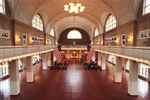Ellis Island
The Ellis Island Immigrant Station was designed by architects Edward Lippincott Tilton and William Alciphron Boring. They received a gold medal at the 1900 Paris Exposition for the building’s design. The architecture competition was the second under the Tarsney Act which had permitted private architects rather than government architects in the Office of the Supervising Architect to design federal buildings.
The federal immigration station opened on January 1, 1892 and was closed on November 12, 1954, but not before 12 million immigrants were inspected there by the US Bureau of Immigration (Immigration and Naturalization Service). In the 35 years before Ellis Island opened, over 8 million immigrants had been processed locally by New York State officials at Castle Garden Immigration Depot in Manhattan.
1907 was the peak year for immigration at Ellis Island with 1,004,756 immigrants processed. The all-time daily high also occurred this year on April 17 which saw a total of 11,747 immigrants arrive.
Mass processing of immigrants at Ellis Island ended in 1924 after the Immigration Act of 1924 greatly restricted immigration and allowed processing at overseas embassies. After this time Ellis Island became primarily a detention and deportation processing center.
Today Ellis Island houses a museum reachable by ferry from Liberty State Park in Jersey City, New Jersey and from the southern tip of Manhattan in New York City. The Statue of Liberty, sometimes thought to be on Ellis Island because of its symbolism as a welcome to immigrants, is actually on nearby Liberty Island, which is about 1/2 mile to the south. There is also ferry service between the two islands.
